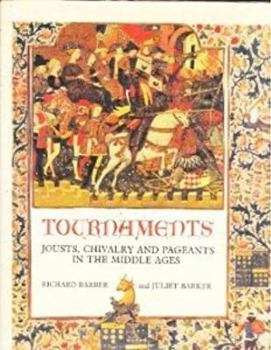Tournaments: Jousts, Chivalry, and Pageants in the Middle Ages
Select Format
Select Condition 
Book Overview
The first serious study of tournaments throughout Europe reveals their importance - in the training of the medieval knight, the development of arms and armour, as an instrument of political patronage,... This description may be from another edition of this product.
Format:Hardcover
Language:English
ISBN:1555844006
ISBN13:9781555844004
Release Date:January 1989
Publisher:Grove/Atlantic
Length:225 Pages
Weight:2.95 lbs.
Customer Reviews
3 ratings
Medieval Fighting for Fun!
Published by Thriftbooks.com User , 19 years ago
In Tournaments, Richard Barber and Juliet Barker set out to trace the development of tournaments from the early melees to the later elaborate spectacles. Barber and Barker believe that tournaments were an important part of medieval society as well as a form of training for knights. They also believe that while tournaments certainly had a strong influence on romantic literature, the tournaments were themselves influenced by romantic literature. To support their arguments, the authors rely heavily on chronicles written during the medieval period. The authors place the emergence of tournaments as a distinct game at the end of the eleventh century in France. They also link it to the development of the use of a couched lance.(14) One important distinction made by the authors is the difference between the technical tournament, which was the melee and the hastilude, which was from the Latin meaning a game fought with spears. While the term "Tournament" has become a word meaning virtually any sport involving knights, and brings up visions of knight jousting, this was not the terminology of the medieval knight. According to the authors, around 1170, new romances began to replace such works as Chansons de gests. Such new romances began to place importance on courtly love and heroism. "Thus a kind of symbiosis developed between tournaments and courtly literature, each feeding on the other and thereby encouraging their mutual development."(21) The authors examine the tournament as it manifested in several different countries. England and France for example differed greatly by the end of the twelfth century, with France prohibiting and England licensing tournaments. However, in 1316 Pope John XXII lifted bans on tournaments, which paved the way for legal tournaments in France. The authors also examine the circumstances under which a tournament might occur. Many were indeed held as sporting events; however, several were planned as an excuse to establish a revolt or to settle a personal grievance. Other tournaments occurred as part of a battle during a siege, where attackers and defenders challenged each other to combat, either personal or in groups. The authors place the beginning of the German tournament around the mid-twelfth century. From Germany the authors provide an excellent example of romantic literature influencing tournaments when a German knight, Waltmann von Stenstete sought challenges from knights with his female companion as a part of the prize for his defeat. There is also Ulrich von Liechtenstein who pursues jousts, but whose narrative the authors claim is full of literary devices making it difficult to tell where fact and fancy begin and end. According to the authors, by the fourteenth century, Germany also had two different types of tournaments. There were regular events, often organized locally, and there were tournaments for special aristocratic or imperial occasions. (37) It was in Germany that societies dedicated
Excellent
Published by Thriftbooks.com User , 20 years ago
Easily the best general book on Tournaments available. Some people might have wanted to more detail in certain areas buut when you concider what the authors are trying to achieve I feel they found an excellent balance.
Everything you wanted to know about tournaments...
Published by Thriftbooks.com User , 21 years ago
While books about tournaments usually just describe what tournaments generally were like .., this book takes a look at the actual historical events themselves. It describes many historical tournaments, famous participants, the backgrounds and the changing nature of the events from the Middle Ages to the Renaissance etc. In fact, the book tries to cover almost everything related to tournaments (from public disorder in tournaments to the time of day). Even so, the book holds together well and is easy to read. It is illustrated with fine historical paintings and drawings from books of the time with only a couple of photos (no modern or dismal 19-Century historical sketches). As a 'better-than-most' book, it's only weakness is that with a mere 200+ pages it can only give a quick synthesis about the various topics it examines. For instance, the well written chapter on tournament armour could have been a bit longer (only 12 pages). In all, the best book about tournaments so far. But still hoping for even a better book...






